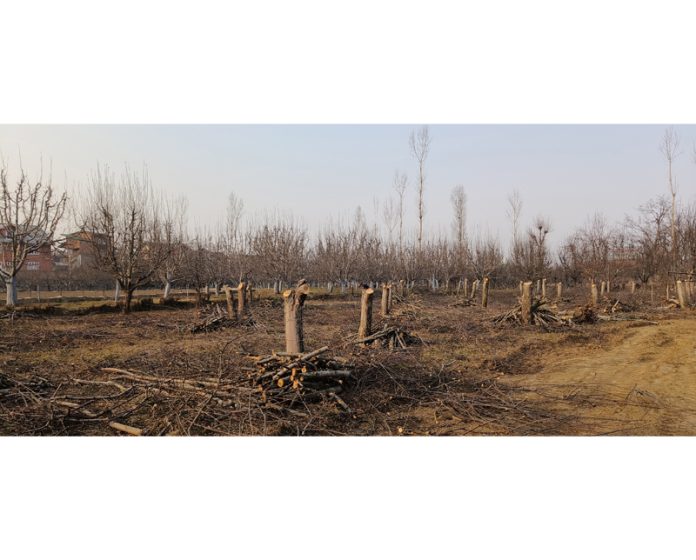
Suhail Bhat
SRINAGAR, Jan 8: The farmers in Pulwama district are transforming traditional orchards into high-density apple farms, covering nearly 500 hectares of land over the last three years and positioning the district as a leader in adopting modern farming techniques.
According to officials from the Department of Horticulture, Pulwama has emerged as a leader in adopting new farming techniques, outpacing other districts in the Valley.
Over the last five years, Pulwama has contributed significantly to the establishment of high-density apple orchards. Official figures reveal that out of the total 500 hectares converted under the high-density plantation scheme since 2018 in Kashmir, approximately 40 percent, equivalent to around 200 hectares, is from Pulwama alone. This statistic underscores the district’s enthusiastic embrace of the innovative farming technique.
Chief Horticulture Officer Pulwama, Javeed Ahmad, emphasised the success ratio of production, quality and returns as key drivers behind the increasing interest in high-density plantations. “Keeping in view the success ratio of production, quality, and simultaneously the return of the farmers who adopted high-yielding varieties, more and more people are showing interest in the high plantation scheme. Initially, the farmers were sceptical, but now the people are generously accepting it,” he said.
Highlighting the advantages, Ahmad explained that high-yielding varieties bear fruit within the second year of plantation, compared to traditional plants that require nearly eight years. Over the past three years, approximately 719 farmers in the district have benefited from high-yielding apple varieties, with an average orchard size of around one kanal of land. “It can provide permanent employment to the farmers, and our target is to bring 43 hectares more under the high-density apple scheme in the district this year,” he said.
Farmers in the district are making a significant shift by replacing orchards that are four to five decades old with high-density apple orchards, inspired by the prosperous results achieved by their peers. The demand for high-density varieties has witnessed a substantial increase in recent seasons, prompting more farmers to adopt these advanced techniques.
Tufail Ahmad, a grower from Pulwama with high-density apples on approximately 24 kanals of land, shared his experience of transitioning from traditional to high-yield varieties. “We had an old orchard of traditional fruit-bearing trees, but the yield was not so rewarding, and I decided to switch over and sow high-yield varieties,” he explained.
Another grower, Mohammad Lateef from Anantnag, highlighted the remarkable difference in yield and resource consumption, “The yield of high-density apple trees is at least five times higher than that of traditional varieties, with 80 percent less consumption of fertilisers and pesticides. In June last year, I spent around 2 lakhs to plant high-density apples, and this year I have already got more than half of the amount spent,” he said.

